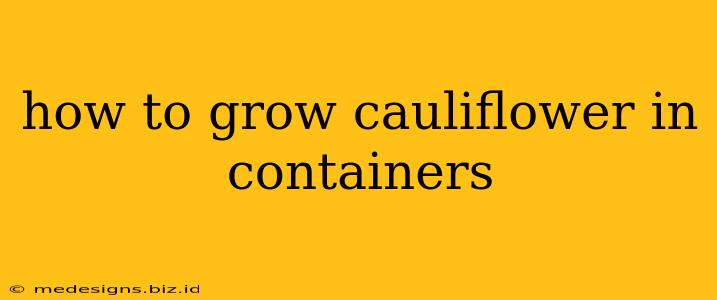Growing your own cauliflower, even in a small space, is incredibly rewarding. This comprehensive guide will walk you through everything you need to know about successfully cultivating cauliflower in containers, from choosing the right variety to harvesting your delicious crop.
Choosing the Right Cauliflower Variety
Not all cauliflower varieties are created equal when it comes to container gardening. Opt for compact varieties that are bred specifically for smaller spaces. Look for descriptions mentioning "bushy" or "compact" growth habits. These varieties won't become as large as their field-grown counterparts, making them ideal for containers. Check seed packets or plant tags for specific recommendations.
Recommended Cauliflower Varieties for Containers:
- Early varieties: These mature quickly, often within 60-70 days, making them a good choice for shorter growing seasons.
- Compact varieties: Look for varieties described as "compact" or "bushy," ensuring they won't outgrow their container.
Selecting the Perfect Container
The size of your container is crucial. Cauliflower needs ample space for its root system to develop properly. A container at least 12 inches (30cm) in diameter and 12 inches (30cm) deep is recommended for a single plant. Larger containers are even better, allowing for more robust growth.
Container Material Considerations:
- Plastic: Plastic containers are lightweight, inexpensive, and readily available.
- Terracotta: Terracotta pots offer excellent drainage but can dry out quickly, requiring more frequent watering.
- Wood: Wooden containers add a rustic charm but need to be treated to prevent rot and water damage.
Ensure your chosen container has drainage holes to prevent root rot.
Preparing Your Container and Soil
Before planting, prepare your container and soil to ensure optimal growing conditions. Use a high-quality potting mix specifically formulated for vegetables. This type of mix provides good drainage and aeration, crucial for healthy cauliflower growth. Avoid using garden soil directly from your yard, as it may contain compacted soil or diseases.
Soil Preparation Steps:
- Fill your container with the chosen potting mix, leaving about an inch of space from the top.
- Water thoroughly to settle the soil and ensure even moisture.
- Allow excess water to drain completely before planting.
Planting Your Cauliflower
Once your soil is prepared, it's time to plant your cauliflower seedlings or start seeds directly in the container.
Planting Seedlings:
- Carefully remove the cauliflower seedlings from their starter pots or cells.
- Create a hole slightly larger than the seedling's root ball.
- Gently place the seedling in the hole, ensuring the top of the root ball is level with the soil surface.
- Fill in around the seedling with potting mix, gently firming the soil around the base.
- Water thoroughly after planting.
Direct Sowing:
- Sow seeds about ¼ inch deep and 1-2 inches apart.
- Once seedlings have emerged and are large enough to handle, thin them to one plant per container.
- Water gently after sowing.
Caring for Your Container-Grown Cauliflower
Providing the right care is essential for a bountiful cauliflower harvest.
Watering:
Consistent moisture is critical for cauliflower growth. Water regularly, ensuring the soil remains moist but not soggy. Check the soil moisture regularly, especially during hot and dry weather.
Fertilizing:
Feed your cauliflower regularly with a balanced liquid fertilizer, following the product's instructions. This provides the essential nutrients required for healthy growth and curd development.
Sunlight:
Cauliflower needs at least 6-8 hours of direct sunlight daily. Choose a sunny location for your container.
Pest and Disease Control:
Monitor your plants regularly for pests and diseases. Treat any issues promptly using organic or chemical methods, as appropriate.
Harvesting Your Cauliflower
Your cauliflower is ready for harvest when the curd (the white head) is firm and dense. The size will vary depending on the variety you chose. Use a sharp knife to cut the curd, leaving about an inch of stem attached.
Troubleshooting Common Problems
- Yellowing Leaves: This could indicate nutrient deficiencies, underwatering, or pest infestation.
- Small Curds: Insufficient sunlight, inadequate fertilization, or overcrowding can result in smaller curds.
- Bolting: Cauliflower bolting (producing a flower stalk instead of a curd) often occurs due to excessive heat or drought stress.
By following these guidelines, you'll be well on your way to enjoying homegrown cauliflower from your container garden! Remember, patience and consistent care are key to a successful harvest.
